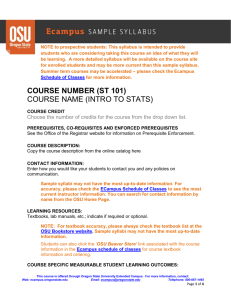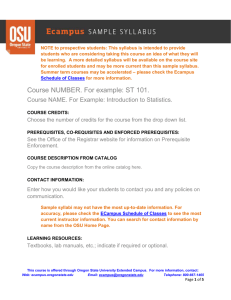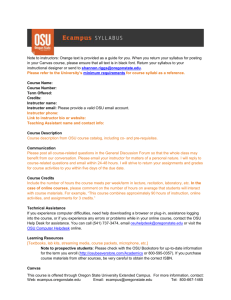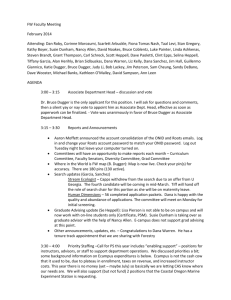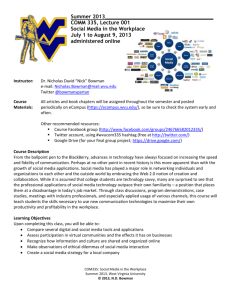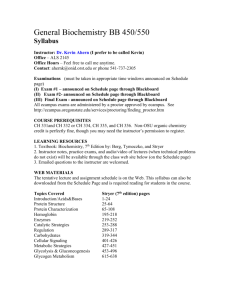ch 331 organic chemistry - Oregon State University
advertisement
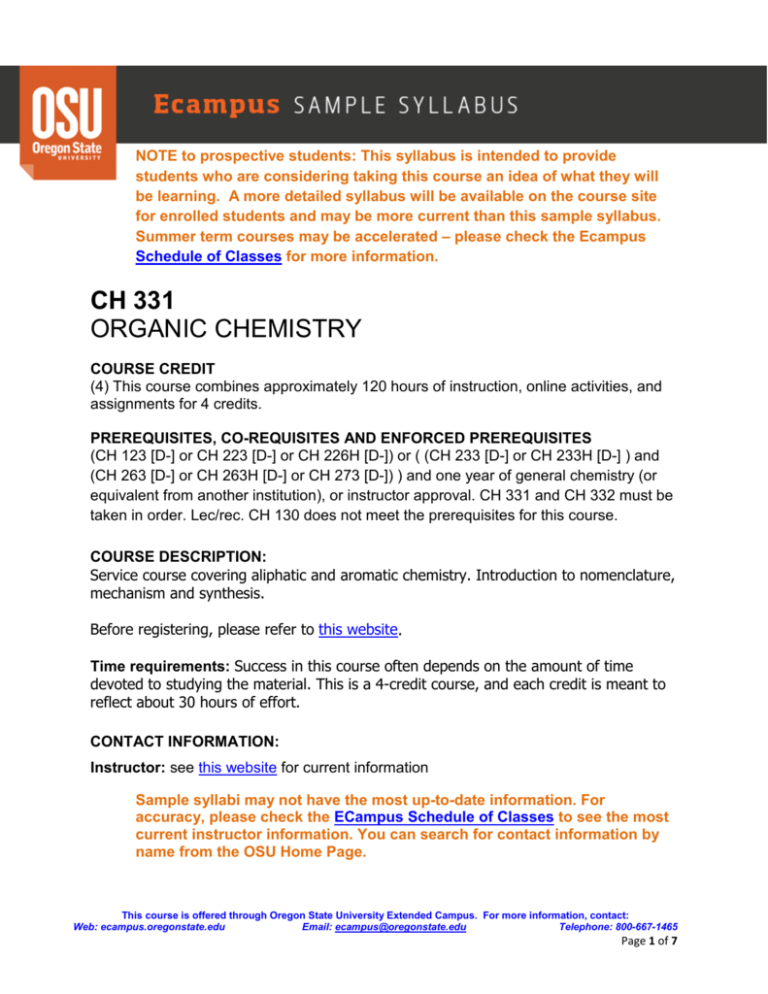
NOTE to prospective students: This syllabus is intended to provide students who are considering taking this course an idea of what they will be learning. A more detailed syllabus will be available on the course site for enrolled students and may be more current than this sample syllabus. Summer term courses may be accelerated – please check the Ecampus Schedule of Classes for more information. CH 331 ORGANIC CHEMISTRY COURSE CREDIT (4) This course combines approximately 120 hours of instruction, online activities, and assignments for 4 credits. PREREQUISITES, CO-REQUISITES AND ENFORCED PREREQUISITES (CH 123 [D-] or CH 223 [D-] or CH 226H [D-]) or ( (CH 233 [D-] or CH 233H [D-] ) and (CH 263 [D-] or CH 263H [D-] or CH 273 [D-]) ) and one year of general chemistry (or equivalent from another institution), or instructor approval. CH 331 and CH 332 must be taken in order. Lec/rec. CH 130 does not meet the prerequisites for this course. COURSE DESCRIPTION: Service course covering aliphatic and aromatic chemistry. Introduction to nomenclature, mechanism and synthesis. Before registering, please refer to this website. Time requirements: Success in this course often depends on the amount of time devoted to studying the material. This is a 4-credit course, and each credit is meant to reflect about 30 hours of effort. CONTACT INFORMATION: Instructor: see this website for current information Sample syllabi may not have the most up-to-date information. For accuracy, please check the ECampus Schedule of Classes to see the most current instructor information. You can search for contact information by name from the OSU Home Page. This course is offered through Oregon State University Extended Campus. For more information, contact: Web: ecampus.oregonstate.edu Email: ecampus@oregonstate.edu Telephone: 800-667-1465 Page 1 of 7 LEARNING RESOURCES: NOTE: For textbook accuracy, please always check the textbook list at the OSU Bookstore website. Sample syllabi may not have the most up-to-date information. Students can also click the ‘OSU Beaver Store’ link associated with the course information in the Ecampus schedule of classes for course textbook information and ordering. COURSE SPECIFIC MEASURABLE STUDENT LEARNING OUTCOMES: The successful student will: 1. Nomenclature a. be able to give IUPAC names of alkanes, cycloalkanes, alkenes, alkyl halides and alkynes 2. Drawing conventions a. be able to use/interpret perspective formulas, Newman projections and Fischer projections 3. Bronsted Lowry acid/base chemistry a. given the reactants be able to predict the products, determine the equilibrium constant and display the mechanism via curved arrow formalism b. be able to rank acids according to their relative acid strengths c. be able to rank bases according to their relative base strengths 4. Lewis acid/base chemistry a. given the reactants be able to predict the products and display the mechanism via curved arrow formalism 5. 5. Alkanes/cycloalkanes a. be able to estimate strain energies of simple alkanes, cycloalkanes and subsituted cyclohexanes b. be able to determine the preferred conformation of a substituted cyclohexane 6. Alkenes a. given the reactants be able to predict the products of alkene hydrohalogenation, hydration, halogenation, oxymercuration-reduction and hydroboration-oxidation, predict and explain the distribution of products and display the mechanism via curved arrow formalism b. given the reactants be able to predict the products of alkene hydrogenation, hydroxylation and oxidative cleavage and predict and explain the distribution of products This course is offered through Oregon State University Extended Campus. For more information, contact: Web: ecampus.oregonstate.edu Email: ecampus@oregonstate.edu Telephone: 800-667-1465 Page 2 of 7 7. Alkyl halides a. given an alkyl halide substrate in conjunction with a nucleophile or base be able to predict the product(s), including stereochemical outcome, of substitution (SN1/SN2) or elimination (E1/E2), predict and explain the distribution of products and display mechanism via curved arrow formalism b. you know the differences and similarities between a nucleophile and a base and their use in substitution and elimination c. be able to recognize likely substrates for SN1/SN2 substitutions and E1/E2 eliminations in terms of leaving group and alkyl halide substrate degree (i.e., methyl, primary, secondary, or tertiary) 8. Alkynes a. given the reactants be able to predict the products of alkyne hydrohalogenation, hydration, halogenation, and hydrogenation, predict and explain the distribution of products and display the mechanism via curved arrow formalism b. you understand how alkyne products are prepared from double elimination of dihalides and display the mechanism via curved arrow formalism c. you understand the formation of acetylide ions from deprotonating terminal alkynes and their subsequent use in substitution chemistry and display mechanistic details via curved arrow formalism 9. Stereochemistry a. understand the core concept of "chirality" and can describe this in terms of "handedness" or of superimposability of a mirror image. In addition, you can recognize achiral objects that contain an internal plane of symmetry. b. be able to describe the relationship between the presence of one or more asymmetric center and the chirality of a molecule (or the lack thereof). c. be able to use the Cahn-Prelog-Ingold system to identify group priorities around an atom and define whether the absolute stereochemistry of a particular compound is R or S d. know the definitions of key stereochemical relationships: enantiomers and diastereomers e. know the impact of chirality on "optical activity" (rotation of the plane of polarization for plane-polarized light). You understand the consequence on optical activity for mixtures of stereoisomers. This course is offered through Oregon State University Extended Campus. For more information, contact: Web: ecampus.oregonstate.edu Email: ecampus@oregonstate.edu Telephone: 800-667-1465 Page 3 of 7 COURSE CONTENT AND POLICIES: Course Content: 1. Review of Lewis structures; hybridization; bonding; acid/base chemistry, Stereochemistry 2. Alkanes: nomenclature and physical properties of alkanes and cycloalkanes; conformational analysis of acyclic alkanes and cycloalkanes; halogenation of alkanes and cycloalkanes 3. Alkenes I: structure, nomenclature and physical properties of alkenes; addition of hydrogen halides to alkenes; carbocation rearrangements; addition of water to alkenes; addition of alcohols to alkenes 4. Alkenes II: addition of halogens to alkenes (conversion to vicinal dihalides, halohydrins, and related compounds) 5. Alkenes III; redox reactions in organic chemistry; hydrogenation of alkenes; hydroxylation of alkenes; hydroboration-oxidation of alkenes; oxidative cleavage of alkenes 6. Alkyl Halides I: structure, nomenclature and physical properties of alkyl halides; the SN1 reaction; factors affecting the rate of an SN1 reaction; the SN2 reaction; factors affecting the rate of an SN2 reaction 7. Alkyl Halides II: structure, nomenclature and physical properties of alkyl halides; the E1 reaction; the E2 reaction 8. Alkynes: structure, nomenclature and physical properties of alkynes; addition of hydrogen halides; addition of water; addition of halogens; addition of hydrogen; acetylide ions Exams: Students will take an 80 minute, proctored* midterm exam during a specific time window in week 6 of the term. Students will take a 110 minute, proctored* final exam during a specific time window during Finals week. The final exam is comprehensive. *Proctoring guidelines and registration for proctored exams are available online at the following link: http://ecampus.oregonstate.edu/services/proctoring/ No make-up midterm exams will be given. If a student misses the midterm exam due to illness (or other excused absence), the final will count for 140 pts. This course is offered through Oregon State University Extended Campus. For more information, contact: Web: ecampus.oregonstate.edu Email: ecampus@oregonstate.edu Telephone: 800-667-1465 Page 4 of 7 EVALUATION OF STUDENT PERFORMANCE: Grading Midterm Exam** Final Exam Blackboard Quizzes Final Score Maximum Points 60 80 60 200 **If the % grade of your final exam is higher than the % grade of your midterm exam, then your final exam % grade will be used to replace your midterm exam grade (as a %). COURSE SITE LOGIN INFORMATION Information on how to login to your course site can be found HERE. STATEMENT REGARDING STUDENTS WITH DISABILITIES Oregon State University is committed to student success; however, we do not require students to use accommodations nor will we provide them unless they are requested by the student. The student, as a legal adult, is responsible to request appropriate accommodations. The student must take the lead in applying to Disability Access Services (DAS) and submit requests for accommodations each term through DAS Online. OSU students apply to DAS and request accommodations at our Getting Started with DAS page. Accommodations are collaborative efforts between students, faculty and Disability Access Services (DAS). Students with accommodations approved through DAS are responsible for contacting the faculty member in charge of the course prior to or during the first week of the term to discuss accommodations. Students who believe they are eligible for accommodations but who have not yet obtained approval through DAS should contact DAS immediately at 541-737-4098. Additionally, Canvas, the learning management system through which this course is offered, provides a vendor statement certifying how the platform is accessible to students with disabilities. ACADEMIC INTEGRITY AND STUDENT CONDUCT (OSU POLICY) Students are expected to be honest and ethical in their academic work. Intentional acts of academic dishonesty such as cheating or plagiarism may be penalized by imposing an “F” grade in the course. Student conduct is governed by the universities policies, as explained in the Office of the Dean of Student Life: Student Conduct and Community Standards. In an academic community, students and faculty, and staff each have responsibility for maintaining an This course is offered through Oregon State University Extended Campus. For more information, contact: Web: ecampus.oregonstate.edu Email: ecampus@oregonstate.edu Telephone: 800-667-1465 Page 5 of 7 appropriate learning environment, whether online or in the classroom. Students, faculty, and staff have the responsibility to treat each other with understanding, dignity, and respect. Students are expected to conduct themselves in the course (e.g. on discussion boards, email postings, etc.) in compliance with the university's regulations regarding civility. Students will be expected to treat all others with the same respect as they would want afforded to themselves. Disrespectful behavior (such as harassing behavior, personal insults, inappropriate language) or disruptive behaviors are unacceptable and can result in sanctions as defined by Student Conduct and Community Standards. For more info on these topics please see: • Statement of Expectations for Student Conduct • Student Conduct and Community Standards - Offenses • Policy On Disruptive Behavior PLAGIARISM You are expected to submit your own work in all your assignments, postings to the discussion board, and other communications, and to clearly give credit to the work of others when you use it. Academic dishonesty will result in a grade of “F.” • Statement of Expectations for Student Conduct • Avoiding Academic Dishonesty TECHNICAL ASSISTANCE If you experience computer difficulties, need help downloading a browser or plug-in, assistance logging into the course, or if you experience any errors or problems while in your online course, contact the OSU Help Desk for assistance. You can call (541) 7373474, email osuhelpdesk@oregonstate.edu or visit the OSU Computer Helpdesk online. • COURSE DEMO • GETTING STARTED TUTORING For information about possible tutoring for this course, please visit our Ecampus NetTutor page. Other resources include: • Writing Center • Online Writing Lab STUDENT EVALUATION OF TEACHING The online Student Evaluation of Teaching form will be available in week 9 and close at the end of finals week. Students will be sent instructions via ONID by the Office of Academic Programs, Assessment, and Accreditation. Students will log in to “Student This course is offered through Oregon State University Extended Campus. For more information, contact: Web: ecampus.oregonstate.edu Email: ecampus@oregonstate.edu Telephone: 800-667-1465 Page 6 of 7 Online Services” to respond to the online questionnaire. The results on the form are anonymous and are not tabulated until after grades are posted. Course evaluation results are very important and are used to help improve courses and the learning experience of future students. Results from questions are tabulated anonymously and go directly to instructors and unit heads/supervisors. Unless a comment is “signed,” which will associate a name with a comment, student comments on the open-ended questions are anonymous and forwarded to each instructor. “Signed” comments are forwarded to the unit head/supervisor. REFUND POLICY INFORMATION Please see the Ecampus website for policy information on refunds and late fees. This course is offered through Oregon State University Extended Campus. For more information, contact: Web: ecampus.oregonstate.edu Email: ecampus@oregonstate.edu Telephone: 800-667-1465 Page 7 of 7
